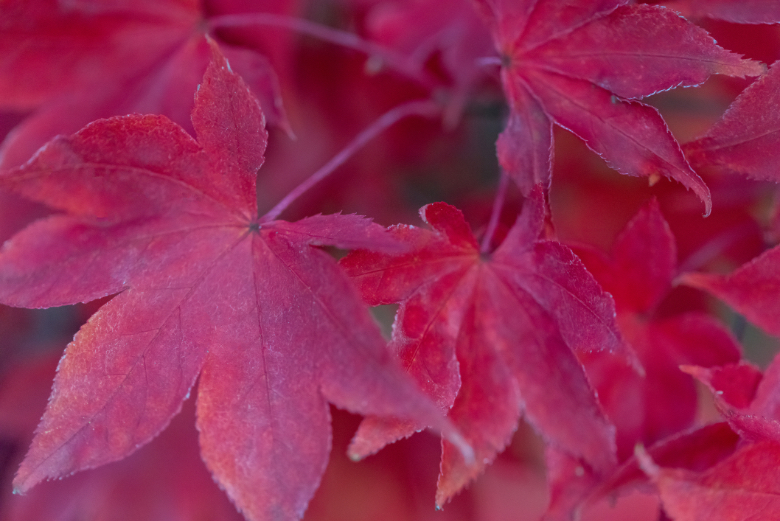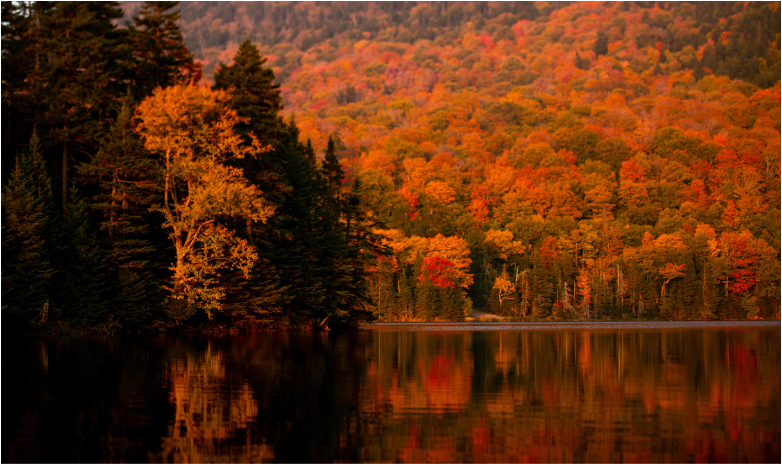For some time now, the economy of the New England region in the north-east of the United States has been boosted by a very peculiar industry: autumn. In recent years, leaf peeping has become a popular activity in states such as Massachusetts, Vermont and New Hampshire, attracting tourists who visit these landscapes to enjoy fall colours. According to University of Vermont forest scientist William Keeton, leaf peepers bring an estimated $800 million to the state each year.
What is it about autumn in New England?
The answer is a spectacular range of hues, including, as New York poet Walt Whitman described it, “red, yellow, drab, purple, and light and dark green.” Anyone who has seen it for themselves can attest that Whitman was not being overly fanciful. In Europe, we are accustomed to autumns where we could describe the colours in many shades, but always of yellow. The phenomenon that autumns in North America and East Asia are dominated by reds, as opposed to European yellows, has been known for a long time: in Europe there are only 24 tree species that turn red, compared to 89 in North America and more than 150 in East Asia. But it is difficult enough to understand how leaf colouration works, let alone why there are differences between regions.

But let us begin, as in every story, by going back to the beginning. In spring, deciduous trees and shrubs begin to produce leaves, the energy generators of vegetation. The plant takes advantage of the sun and the nutrients of the favourable season to invest a great deal of effort in making leaves and stuffing them full of chlorophyll, the green pigment capable of converting sunlight and carbon dioxide into energy and organic compounds. Alongside chlorophyll are other yellow and orange pigments called carotenoids, such as those that give carrots their colour, but their hues are masked by green.
When autumn arrives, the plant must retract its sails and prepare to withstand the rigours of winter in a state of minimal activity. The leaves are no longer needed, so the plant stops producing chlorophyll and recycles all the valuable nutrients from its solar panels back into its woody body. The leaf is dying, but before it does, the lack of chlorophyll exposes the yellow colours of the carotenoids. When the leaf dries up and falls from the tree, it is nothing more than an empty shell with nothing left to use.
In North American and East Asian trees, however, something unusual happens. In fall, the trees begin to produce a different pigment called anthocyanin, which is red in colour; in New England up to 70% of the species can produce anthocyanin, compared with 10% in other regions. While this explains the difference in colour, it is another matter to understand why the plant would put so much effort into producing a new pigment when the leaf is about to be shed.
So much for the facts. The questions now are: what is the biological purpose of anthocyanin production and why do European trees do without it? One hypothesis for the first question is that the red colour deters insects. Aphids, or plant lice, avoid laying their eggs on leaves with anthocyanin, which plants produce as a kind of warning sign: “Danger! Defensive chemicals present.” So the benefit is mutual: the aphids know how to avoid the plants that could kill them, and the plants manage to avoid infestation. Proponents of this hypothesis, first published in 2001, propose it as an example of co-evolution between a parasite and its host.

Although there are other theories about the role of anthocyanin, it is this explanation that researchers Simcha Lev-Yadun, from the University of Haifa-Oranim (Israel), and Jarmo Holopainen, then at the University of Kuopio (Finland) and now at the University of Eastern Finland, took as their premise. From this Scandinavian country, the Israeli scientist explains that in 2008 he came to Finland to try to understand the enigma of autumn colours in Europe and America. “I rented a car and went out into the forests to see for myself what was going on,” recalls Lev-Yadun.
“Nature teaches you things that books cannot.”
“On the second day, I was in the centre of the belt, which was at the peak of its golden-yellow colouring. I drove about 600 kilometres from Kuopio and saw millions of yellow trees, but also millions of red bushes growing under the trees,” Lev-Yadun recounts. “At one of my stops, while taking photographs and field notes, I understood the principle.”
According to Lev-Yadun and his colleague Holopainen, who knows all the secrets of the local ecology, the trees and their insect attackers are exposed to extreme temperatures in winter, while the bushes are covered with snow. “They have a natural igloo,” says Lev-Yadun. So trees do not need the red colour because their parasites die off during the cold season, while Scandinavian shrubs keeping warm under the snow need to maintain this protection. This was “the first step in solving the enigma,” says the researcher.
So why have North American and Asian trees been forced to keep their warning signs, while European trees have been able to do without them? To unravel the mystery, the scientists broadened their focus to include geographical and climatic conditions in the planet’s recent history, and noticed a curious fact: in Europe, the main mountain ranges run from east to west, while in America and East Asia they run from north to south. We humans live in what is as known as the Quaternary glaciation, an ice age characterised by glacial periods of intense cold and interglacial periods, such as the present one, with more moderate temperatures.
“From other studies on global climate change, especially in the Pleistocene, we knew that extinctions [due to cold] have been much stronger in Europe because of the direction of the mountains,” Lev-Yadun explains. In other words, North American species, including plant parasites, were able to migrate south during periods of extreme cold, while in Europe they were blocked by mountain ranges and trapped by the ice. Free from pests, European trees were able to avoid the costly burden of anthocyanin production.

“Differences in biological richness, unequal extinctions, insect physiology and the different defence mechanisms of red and yellow leaves all combine to support the hypothesis,” says Lev-Yadun. The two researchers’ work, published in the journal New Phytologist, “attracted a lot of interest from the scientific community and the media, so much so that some saw it as the solution to many unknowns and stopped studying autumn colouring.” “But we still have many questions that will take years to answer,” the scientist concludes.
Susanne Renner of the University of Munich and Constantin Zohner of the ETH Zurich Polytechnic asked themselves one such question: if co-evolution with parasites is the explanation, why do some experiments show that the same plants produce more anthocyanins at high light intensities and colder temperatures? According to Renner and Zohner, eastern North America and Asia receive more sunlight in autumn at the same latitude as Europe, and the New England climate is more prone to sudden frosts. Their experiments suggest that anthocyanin acts as a sunscreen, shielding leaves from this excess light that interferes with nutrient reabsorption and allowing the process to complete before a sudden frost. Interestingly, species that live in symbiosis with nitrogen-fixing bacteria do not produce anthocyanin, presumably because their symbionts cover a function that avoids reliance on the sunscreen provided by the pigment.
The effects of climate change
But whatever the explanation, a major threat now looms over the phenomenon of colourful fall foliage: climate change. Renner herself told of travelling to Vermont based on the predictions of when the colours would be at their most intense, only to be frustrated by what was still a blanket of green. The truth is that warmer autumns are delaying the arrival of autumnal hues in a way that anyone can see, and this is backed up by scientific data: since the 19th century, maple leaf colouration in North America has been delayed by more than a month. But the long-term situation may be more complex, and its impact far greater than a simple change in dates.

Some models suggest that by the end of this century, autumn colours could be delayed by one to three weeks. As summers lengthen, autumns shorten, and winters set in without allowing enough time for the nutrient reabsorption process to take place, trees will lose their strength to grow back vigorously the following spring. And as trees grow weaker, their ability to sequester carbon will diminish, exacerbating the problem of climate change in a destructive feedback loop.
But according to Renner, what is actually happening is more complicated, though no less pernicious. The production of anthocyanin is reduced by warmer falls, resulting in muted foliage colours. However, a study by Renner, Zohner and their collaborators suggest that there is an effect at play that counteracts the delay in autumn colour: leaf productivity has a limit. As this productivity increases due to warmer temperatures, the leaves will use up available nutrients (in particular nitrogen) and fall earlier, compensating for the delay. “The end result,” says Renner, “is that leaves still start to die after about the same amount of time on the tree as they have in years and even decades past.”
So from the middle to the end of this century, autumn leaf colour could actually start up to almost a week earlier. This, the researchers write, “reveals important constraints on future growing-season lengths and carbon uptake of trees.” Whichever way you look at it, autumn colours will be a symptom of the health of the planet’s climate, and they don’t look good.
Comments on this publication